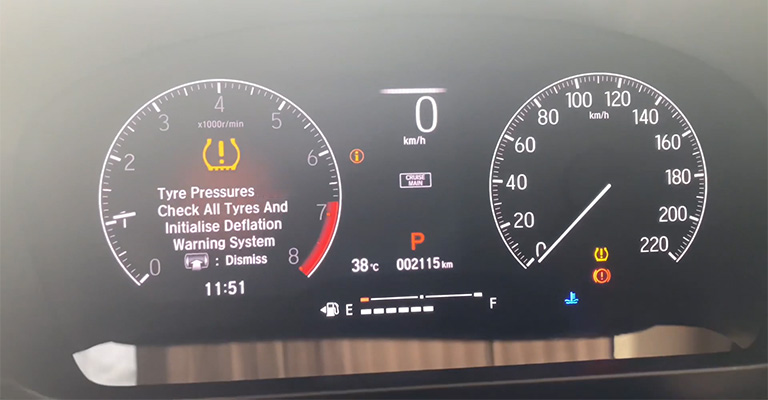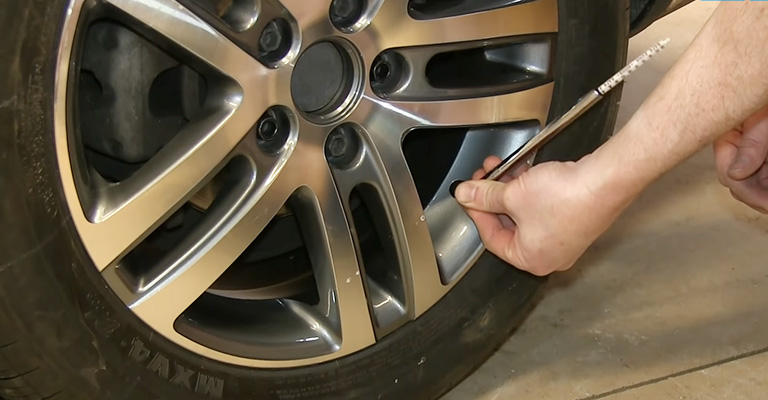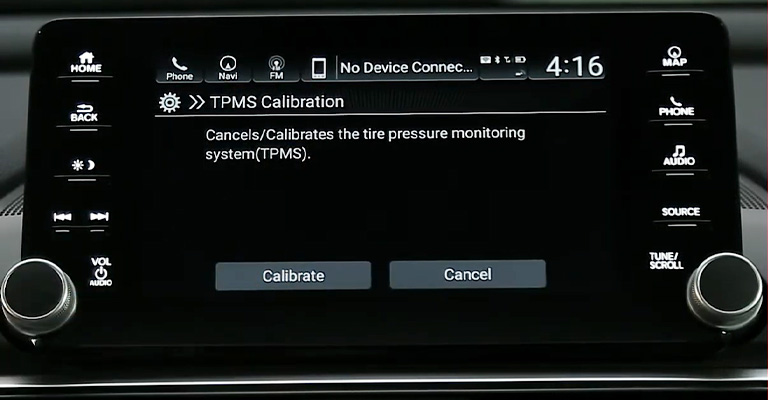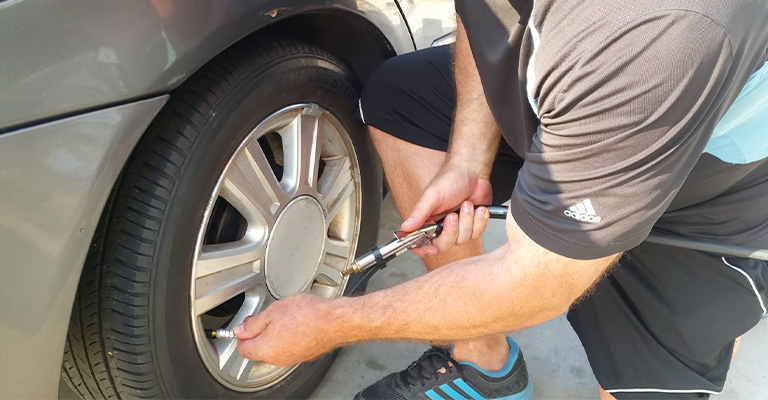In order to maintain a vehicle’s safety and performance, it is important to maintain the correct tire air pressure. Maintaining your vehicle’s tire pressure is a necessary part of vehicle maintenance, but it’s easy to forget.
Maybe you’re wondering: what is the recommended tire pressure?
In general, passenger cars’ psi requirements will range between 30 and 35 psi, but some vehicles will fall outside of that range, and every vehicle will have its own requirements.
Your vehicle’s tire placard or owner’s manual will tell you how much pressure your tires should have when they are properly inflated.
There may be differences in the PSI of the front and rear tires, so it is important to get the proper PSI from both the placard and the manual.

Why Do I Need To Maintain Proper Tire Pressure?
Having the right tire pressure ensures that tires wear evenly, provides a smooth ride, and improves fuel efficiency. Tire blowouts and tread tears can also be prevented with proper inflation.
Whenever your tires become threadbare, worn, or damaged, it’s time to replace them. The right tire pressure not only saves you money and ensures your safety, but it also reduces the impact on the environment.
As much as 50% of tire tread life can be lost due to underinflation. Underinflated tires require more fuel to power, so cars burn more fuel when they roll on underinflated tires.
By properly inflating your tires, you extend their lifespan, which leads to fewer landfills accumulating tires.
Fuel consumption can be reduced, natural resources can be preserved, and the environment can be cleaned when tires are kept at the recommended pressure.
How Do I Know What My Tire Pressure Should Be?
You can find your vehicle’s recommended tire pressure in your owner’s manual if you want to learn how to tell how much PSI your tires need.
It is also recommended to place a sticker displaying the correct tire pressure on the vehicle’s door jambs, doorposts, glove box doors, and fuel doors.
Tire pressure varies from vehicle to vehicle what tire pressure is recommended, but most cars recommend three to five PSI (pounds per square inch). It is recommended that tires have 32 to 35 psi of air pressure when they’re cold.
During cold weather, you should check tire pressure because friction between tires and the road generates heat, which increases the temperature and pressure.
If possible, leave the car sitting overnight or for a couple of hours before taking a reading. That will ensure you have the most accurate reading (not to mention the most consistent reading).
If you want to avoid poor brake performance and premature tire wear, you should avoid overinflating your tires.
Underinflated tires will cause premature tire wear due to increased friction, whereas overinflated tires will result in a bouncy ride and an ill-handling car.
You should put your tires at their recommended pressure to achieve maximum tire wear and vehicle performance – and to make your maintenance schedule easier when it comes to replacing your tires.
Maximum Pressure

Ensure that you do not confuse the recommended pressure with the maximum pressure. You can find the recommended pressure in your owner’s manual or on your vehicle’s door jamb when filling your tires.
Tire manufacturers usually display the maximum pressure on the tire’s sidewall near its bead (where the rubber adheres to the rim).
There is a maximum pressure that the tire can safely support. It is measured by the tire manufacturer rather than the car manufacturer.
Minimum Pressure
Most manufacturers specify no standard minimum tire pressure. Using this value, a car can handle properly and safely if its tires are at the recommended pressure.
In other words, the optimal value is also the minimum value because anything below that value isn’t recommended.
U.S. law requires all vehicles to be equipped with tire pressure monitoring systems (TPMS) that inform the driver if the tire pressure falls below the recommended 25 percent.
There are varying degrees of underinflation. Some pressure drops are mild or moderate but can still have negative effects.
How Do You Know Tire Pressure is Low?
There are a few different ways to tell if your tire pressure is low:
Poor Performance

In low-tire-pressure vehicles and those with worn-down treads, the vehicle’s response, and ride quality will be diminished.
Tire Pressure Gauge
Tire pressure can be checked simply by removing your tires’ valve stem caps, inserting a tire pressure gauge into the stem, and pressing down. An accurate PSI reading can be obtained this way.
Tire Pressure Monitor

You may have a newer vehicle with a tire pressure monitoring system, which will warn you when to inflate your tires on your dashboard.
Recommended Honda Tire Pressure
Every Honda sedan or SUV requires a different tire pressure, so you should adjust it accordingly.
Both vehicles have different performance capabilities, drivetrains, body types, and more, so the recommended CR-V tire pressure might differ from the recommended Accord tire pressure.
The following is the suggested tire pressure for Honda models:
| Honda Model | Front Tire Pressure (psi) | Rear Tire Pressure (psi) |
|---|---|---|
| 2020 Pilot | 32 | 32 |
| 2020 Fit (high-speed driving) | 35 | 33 |
| 2020 Fit | 33 | 33 |
| 2020 CR-V | 32 | 32 |
| 2020 Accord (high-speed driving) | 35 | 33 |
| 2020 Accord | 32 | 32 |
| 2020 Civic | 32 | 32 |
| 2020 Odyssey | 35 | 35 |
If you have a previous year’s Honda model and aren’t sure what your proper tire pressure is, check your Honda owner’s manual or the sticker inside your driver’s side door.
How To Check The Tire Pressure?

To ensure your tires are in good order, you should check your tire pressure regularly after knowing the recommended tire pressure for your vehicle.
Mechanics, car parts stores, gas stations, and some homes allow you to check your tire pressure. Checking tire pressure at home requires:
- A Tire Pressure Gauge(Digital or Regular)
- Air Compressor
- Pen and paper / your phone
Step 1: Test With Cold Tires
If possible, you should start with cold tires, as tire pressures vary greatly with temperature and are recommended for cold inflation.
Most people check their tire pressure after a night’s rest to avoid the heat caused by friction after driving.
Step 2: Check The Tire Pressure With The Gauge
The tire gauge needs to be pressed, so the hissing sound disappears after removing the valve cap. Providing the tire gauge is connected to the tire; there should be a reading.
Step 3: Note Down The Readings
If you look in your owner’s manual or inside the driver’s door, you can find the perfect tire pressure for each tire, and you can compare that with the tire pressure stated in the manual or inside the driver’s side door.
If you are changing tires on some vehicles, check the recommended pressure for both the front and rear tires in detail.
Step 4: Fill Your Tires To The Recommended PSI
Underinflated tires can be filled with air using an air compressor. Gas stations have air compressors to rent, or you can buy one at an auto parts store.
For accurate readings, ensure your tires are cold and rest for at least half an hour before checking them.
You should fill your tires when hot with 3-4 psi higher than recommended and check your gauge again when cold.
Filling the tires with air is ok if you overinflate. You can let the air out with the gauge afterward.
Step 5: Check The Tire Pressure Again
Use your tire pressure gauge to carefully check the tire pressure after filling the tires and ensure they are within a good range. It is recommended that you press hard on the valve stem if the tires are overinflated so they can let some air out.
What Should I Know About My Indirect TPMS System?
It is necessary to initialize the TPMS calibration after adjusting your tire pressure if your Honda has the indirect TPMS.
When you reach specific driving parameters, your TPMS (Tire Pressure Monitoring System) will complete its calibration. This low tire pressure light will appear again if the driving parameters are not met.
Please follow the directions below or call us if this happens:
- Make sure all 4 tires are in good condition and don’t have any flat or punctured tires; if possible, double-check the tire pressure or bring your vehicle to Valley Honda for a tire pressure check.
- The tires do not appear visibly low, so if it is not feasible/convenient to check their pressures, you can initialize the TPMS calibration by pressing the left-hand steering wheel button or in the Vehicle Settings menu on the I-MID screen or Infotainment screen (see your owner’s manual for instructions on TPMS calibration).).
- After the calibration has begun, the vehicle will need to be driven 20-30 miles at speeds between 30 mph and 60 mph. Data for speeds that are outside of these parameters will not be stored by the system.
- You can test whether the TPMS has been calibrated properly by turning off the vehicle and putting it into an accessory mode (the engine is off, but the vehicle is running). It is considered complete when the low tire pressure light does not blink after one minute. The drive (step 3) needs to be repeated if the light blinks between 45-60 seconds.
This type of TPMS does not use any sensors mounted on the wheels to monitor tire pressure. Instead of using wheel speed sensors while driving, it uses VSA/ABS sensors to monitor and compare tire speeds.
While driving the calibration drive, the TPMS control unit learns the tire characteristics.
How Do You Inflate Your Tires?
The air pressure in your tires can change with cold weather, so check them every month or so:
- Check the tire pressure of your vehicle at your dealer for no charge.
- If your car needs an air pressure pump, visit a gas station with one (you will probably need quarters for this).
- Tire gauges are helpful for checking tire pressure.
- Make sure the pressure is right for your tires (if any are low, they should be checked for leaks or punctures).
What Does Psi Mean On A Tire?
In spite of the close relation between tire pressure and PSI (pounds per square inch), these concepts are slightly different. Air in the tire creates internal pressure that supports the vehicle’s weight. Generally, tire pressure is measured by how much air is inside the tire.
The PSI unit – or pounds per square inch – is used to quantify tire pressure. PSI is the measurement unit used to express tire pressure, while tire pressure is the amount of air inside the tire.
Vehicles, tire sizes, and load requirements determine the recommended PSI for tires. For tires to last as long as possible and maintain a safe driving experience, it is essential to maintain a proper PSI level regularly.
What Happens If Tire Pressure Is Too High?
As a result of the high air pressure, only the middle of the tire will be in contact with the road, causing the wear to be focused at the center of the tire.
Tires that quickly wear out are a serious problem, but distorted shapes can also result in reduced traction, which is also dangerous.
How Much Does Tire Pressure Increase While Driving?
For every 10 degrees lower in temperature, tires’ inflation pressure drops by one to two psi.
Additionally, in the first 15 to 20 minutes after driving your car, your tires’ pressure will increase by one psi at every five-minute interval.
Is 40 Psi Too High For Tires?
A normal tire pressure of 35 psi and a maximum safe pressure of 44 psi, for example, means that your tires can safely be inflated to 38 or 40 psi.
You can even go as high as 44 psi. It will be harder to ride, but you won’t have to worry about blowouts. Fuel economy may be improved as well as sharper cornering.
Should My Tires Be 32 Or 35 Psi?
For most vehicles, a tire pressure between 32 and 35 PSI is recommended. One can, however, go as low as 20 PSI (despite not being recommended). It is considered a flat tire if the PSI is below 20.
Is 28 Psi Too Low For Tires?
The tire pressure for a passenger car tire should be between 32 psi and 35 psi, so yes, 28 psi is too low. Ensure that every tire is filled to the proper pressure and that the stem caps are securely fastened.
Is 31 Psi Too Low?
The friction in your tires increases the pressure as soon as you start driving. According to technical standards, any PSI lower than the recommended value is too low.
The variance of more than ten percent, however, is considered too low by most. A reading of 31 or 32 PSI is considered underinflated for a car requiring tire inflation to 35 PSI.
Is 45 Psi Good Tire Pressure?
The most common pressure in these situations is 40 psi, and most modern tire designs can withstand up to 44 psi (in some cases more).
The tire may allow you to go up to 44 or even higher if your vehicle has a heavy load, but most vehicles cannot handle this level.
Is 50 Psi Too Much For Tires?
It’s a lot of pressure for a passenger-car tire to have 50 psi. Tires have a maximum allowable pressure written on their sidewalls.
Is It Better To Have Over Inflated Or Under Inflated Tires?
You’ll notice that your car feels slow if it’s underinflated. The underinflation of your tires will also reduce the fuel economy of your vehicle and shorten the life of your tires.
Tires that are overinflated will also have a shorter lifespan. There will also be less contact between the road and the tire, resulting in the car handling badly.
Should All 4 Tires Have The Same PSI?
Tire pressure should be maintained at the same level in all four tires and according to the vehicle manufacturer’s specifications. It is important to ensure that tires wear properly and that the vehicle handles properly.
Final Words
It’s always important to keep an eye on tire pressure when driving safely, and it can increase fuel efficiency and improve safety.

Leave a Reply